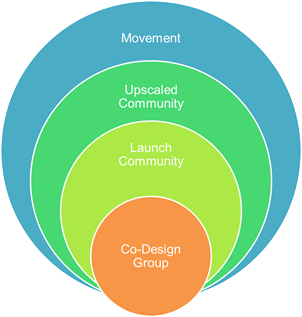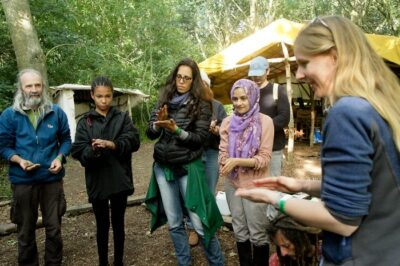Why is it relevant?
The target audience for a Citizen Observatory might be a group of people who live in the same place, they might be similarly impacted by an environmental issue no matter where they live, or they may simply share a concern for a common environmental issue. The aim of building a community is for all observatory members to come to a shared understanding of the issue, the goals of the observatory, the organisation of the observatory, and how to perform and document the tasks ahead.
How can this be done?
Building a community entails raising awareness, supporting and encouraging two-way communication, appointing a community manager and fostering and encouraging deeper engagement.
Lessons learned from the Ground Truth 2.0 project
A community consists of stakeholders who identify or perceive themselves as being a part of it. For Ground Truth 2.0, a community of relevant stakeholders is at the heart of a Citizen Observatory. Community building in the Ground Truth 2.0 project was done by fostering social interactions that led stakeholders to identify with the group outcome, which requires not just intellectual, but also emotional experiences. Visible and symbolic acts, such as signing a consent form, registering an account for an app, posting to an online platform, participating in planning meetings, or in organised data collection campaigns, all served to create a sense of ‘membership’ and being a part of something bigger.
It is also important to distinguish between the initial group who sets up an observatory (often a co-design group) and the long-term community. Ground Truth 2.0 found that it is useful to approach community building in four phases to evolve a Citizen Observatory community from an initial group into a social movement:
- Initiation stage: The first core community members of a Citizen Observatory are recruited. With their input and participation in a co-design process, the observatory starts to take shape.
- Stabilisation stage: Shared group values and norms, important for bonding within any community, are (implicitly or explicitly) developed.
- Enlarging the Citizen Observatory core community: The community of active participants grows. More stakeholder groups will be invited to join, and the interactions in the observatories should multiply.
- Maintaining the community: In this final stage, less attention is directed toward recruitment or gaining the interest of potential new community members. Instead, the established Citizen Observatory focuses on sustaining the community members they have already engaged and on embedding continuity in their interactions.
Lesson learned by the LandSense and GROW projects
In the LandSense Citizen Observatory, a wide range of stakeholders have been involved, so the ways of building community have varied from case to case. In the urban case studies in Vienna, Amsterdam and Toulouse, it has been critical to engage the city administration or different local authorities who will use the data so that they have an interest in participating. In the agricultural case study, farmers and agricultural extension workers have been the key stakeholders, while for forest and habitat monitoring in Indonesia, local communities have been engaged to help co-design the Natura Alert solution. No matter what context we work in, good communication and co-creation have been vital for building strong communities with a vested interest in the success of the Citizen Observatory.
The GROW Observatory ran several citizen science activities. The main soil sensing activity was happening in GROW Places across Europe. When recruiting participants in these places, we followed a set of criteria to make sure we would have a wide range of people from different climates, agricultural contexts and socio-economic contexts. Each GROW Place was coordinated by a local Community Champion. GROW also developed a Community of Practice for Community Champions to foster collaborations across GROW Places and keep up the momentum after the GROW projects had ended.
Useful Resources
TOOL: The Making Sense toolkit includes an Onboarding Kit (p 40-43) with guidance on how to welcome and guide a new participant into the project and the team. It also provides recruitment tips (p 48-51) on how to reach out to multiple relevant communities and how to bring them on board.
PROJECT REPORT: This Ground Truth 2.0 report explains the community building approach and associated stakeholder engagement used in different Citizen Observatories in Europe and Africa.
PROJECT REPORT: This Ground Truth 2.0 report contains methods, techniques and tools for community building during each stage of a larger co-design process of a Citizen Observatory.
You may also be interested in:
I want to set up a Citizen Observatory…
…by identifying a shared issue
…through a suitable co-design process
This work by parties of the WeObserve consortium is licensed under a Creative Commons Attribution-ShareAlike 4.0 International License. ![]()
This page partially draws upon the MOOC Citizen Science Projects: How to make a difference, though the focus was shifted from citizen science projects to Citizen Observatories.


